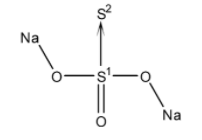
What is the oxidation number of Mn in
Answer
499.5k+ views
Hint: Oxidation number or oxidation state is the charge obtained by the atom of an element when it loses or gains electrons while going from its free state to combined state with atoms of other elements. It can be positive, negative or zero.
Complete answer:
> Oxidation number of alkali metals (e.g. Na, K, Li, etc) is always taken as +1.
> Oxidation number of oxygen is -2 in all of its compounds with a few exceptions. Oxidation state of O in peroxides (e.g.
Oxidation number of Mn in potassium permanganate,
Let the oxidation number of Mn be ‘’. Oxidation of K is +1 and of O is -2.
1(+1)+x+4(-2)=0
1+x-8=0
x=7
Hence, the oxidation number of Mn in is +7.
Oxidation number of S in sodium thiosulphate,
To calculate the oxidation of S in

It has two sulphur atoms in different oxidation states. Since, sulphur
Now let the oxidation number of sulphur
2(+1)+x+1(-2)+3(-2)=0
2+x-2-6=0
x-6=0
x=6
Therefore, the oxidation number of S in
Hence, the oxidation number of Mn in
Note: We commonly make an error while calculating the oxidation number of S in
2+2x+3(-2)=0
2x-4=0
x=2
The two sulphur atoms are present in different oxidation states in
Complete answer:
> Oxidation number of alkali metals (e.g. Na, K, Li, etc) is always taken as +1.
> Oxidation number of oxygen is -2 in all of its compounds with a few exceptions. Oxidation state of O in peroxides (e.g.
Oxidation number of Mn in potassium permanganate,
Let the oxidation number of Mn be ‘’. Oxidation of K is +1 and of O is -2.
1(+1)+x+4(-2)=0
1+x-8=0
x=7
Hence, the oxidation number of Mn in is +7.
Oxidation number of S in sodium thiosulphate,
To calculate the oxidation of S in

It has two sulphur atoms in different oxidation states. Since, sulphur
Now let the oxidation number of sulphur
2(+1)+x+1(-2)+3(-2)=0
2+x-2-6=0
x-6=0
x=6
Therefore, the oxidation number of S in
Hence, the oxidation number of Mn in
Note: We commonly make an error while calculating the oxidation number of S in
2+2x+3(-2)=0
2x-4=0
x=2
The two sulphur atoms are present in different oxidation states in
Recently Updated Pages
Master Class 11 Economics: Engaging Questions & Answers for Success

Master Class 11 Business Studies: Engaging Questions & Answers for Success

Master Class 11 Accountancy: Engaging Questions & Answers for Success

Master Class 11 English: Engaging Questions & Answers for Success

Master Class 11 Computer Science: Engaging Questions & Answers for Success

Master Class 11 Maths: Engaging Questions & Answers for Success

Trending doubts
State and prove Bernoullis theorem class 11 physics CBSE

1 ton equals to A 100 kg B 1000 kg C 10 kg D 10000 class 11 physics CBSE

State the laws of reflection of light

One Metric ton is equal to kg A 10000 B 1000 C 100 class 11 physics CBSE

1 Quintal is equal to a 110 kg b 10 kg c 100kg d 1000 class 11 physics CBSE

Difference Between Prokaryotic Cells and Eukaryotic Cells




